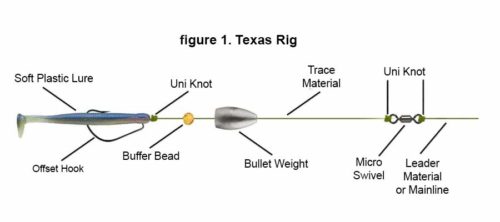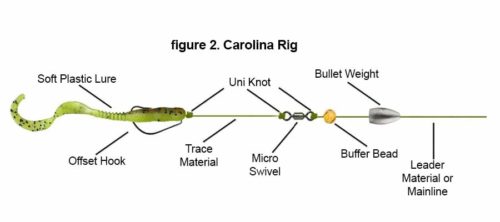Soft plastic bait, commonly known as just plastic bait or soft plastics, is any of a range of plastic-based fishing baits that have a soft, flexible rubber texture. They are designed to imitate fish or other natural aquatic food sources. Because of their realistic texture and versatility they have the soft texture as real food. When a fish strikes a soft plastic bait it feels natural so fish will mouth it longer giving the angler extra time to set the hook.
The diversity of soft plastic baits allows them to be used in many configurations, rigs and with various fishing techniques. They can be cast and trolled, while many work best in vertical presentations such as ice fishing or from piers and are exceptional when float fishing. The most common use of soft plastics is as a simple lure, using a weighted hook known as a jighead. The hook of the jighead is threaded through the lure so that only the gape of the hook, and the eye, are exposed.
Every serious angler should include soft plastics in their fishing tackle. Soft plastics are available in a large range of colors, sizes and shapes.
Plastic Bait Fishing Technique
Methods for fishing soft plastics vary according to the shape of the plastic used, however is it most often cast and retrieved with short, sharp jerky motions applied by the angler through flicking the fishing rod tip. Experienced soft plastic anglers attempt to emulate the natural movement of the animal the soft plastic imitates, such as a prawn, baitfish or crawdad.
Soft plastics are also trolled and jigged in the same method as metal or hardbodied lures, and used as artificial baits in classic real-bait rigs. The many rigs, techniques and uses of soft plastic lures are as varied as the designs, colours and sizes they are available in. Specialised techniques and rigging methods have evolved from anglers targeting specific fish species or in particular areas, such as the Texas rig and Carolina rig.


Types of Soft Plastic Baits
Specific types of soft plastic baits include swimbaits, grubs, worms, tubes, baitfish, eels, slugs and leeches, crawfish, crab and shrimp, creatures, frogs and mice, insects, larvae and waxies, and eggs.
The following are the most common and versatile soft plastic lures.
Worms
The main fish attracting action components of worms are the texture (ringed, ribbed or smooth) affecting the sink rate and the tail (ribbon, twister, paddle, or straight) which provides vibrations when the worm is moved. In rigging a worm, there are two options pre-rigged with a hook or series of hooks, or using a Texas rig the most common, Carolina rig, wacky rig and the drop shot rig.
Grubs
Grubs are composed of soft plastic round body either ringed, ribbed or smooth, combined with single curly tail, double curly split tail, paddle tail, or straight tails for various actions. Grubs come in various lengths from 1″ up to 12″ and hundreds of colors combinations.
The most common use for grubs is tipped on a jig, or as a trailer on a inline spinners and spinner baits. Grubs are also popular to fish using a drop shot rig, split shot rig and Carolina rigs.
Bait Fish
Soft plastic baitfish come in numerous sizes and colors to mimic forage fish. Determine what baitfish are in the waters you are fishing and select a profile size and color to match, for a natural presentation. Usually the smaller the better.
Many soft plastic baitfish baits feature a paddle tail that wiggles when retrieved, but others have curly tails and forked tails that give them swimming action. Fishing soft plastic baitfish imitations are a excellent choice jigged along the bottom or brought in on a straight retrieve.
Tubes
Tubes are rounded hollow soft plastic bodied bait open ended with a series of tentacles on the base. The main body is usually smooth but some have a ribbed exterior. The interior hollow design works well with holding liquid or paste scents. Tubes range in sizes from 1″-2″ for crappies and panfish, 3″-6″ for largemouth and smallmouth bass, and up to 14″ for pike, muskies and larger fish.
Most often tubes are rigged using a weighted tube jig placed within the tube’s body or to make a tube weedless anglers use a wide gap hook threading it through the nose and securing the hook into the body on the outer wall of the tube. Upon casting a tube it will display a spiral action on the fall with the tentacles undulating providing a injured baitfish look, in jigging the tube off the bottom it will appear as a crawfish imitation especially good for feeding smallmouth bass.
Tubes can be rigged as bait using a Texas Rig, Carolina Rig, or on a drop shot rig.
Crawfish
The soft plastic crawfish or crawdad is a deadly on bass when presented along rocky bottom area’s. The main feature of a imitation crawfish is the pinchers when tipped on a jig it gives the bait a realistic defensive posture by raising it’s claws that sends bass a signal to feed. Crawfish soft plastic’s are available from craw trailers to the highly detailed featuring pinchers, antennae, legs, abdomen and tail.
Leeches & Reapers
Leeches and reapers are a basic variation of a soft plastic grub, rounded head and body leading to a soft thin membrane sides. The smaller reapers resemble a leech while the larger reapers mimic baitfish. The sizes start from 3″ for walleye and bass up to 12″ for pike and muskies.
Most anglers rig a leech/reaper tipped on a jig head inserting the hook through the head or use a split shot rig and a single hook. Reapers are a good bait to use on waters that receive a high amount of angling pressure.
Frogs
The advantages of soft-plastic surface frogs are, they are weedless with the hooks positioned against the body, they feel natural with their soft spongy body, so bass, and other fish, will hang on to the lure longer giving more time for the angler to set the hook. When fishing using a top water frog the key is to fish slowly.
After a cast let the frog sit until the ripples subside now pop or twitch the frog once or twice, then let the frog sit for a few seconds and repeat. To change up the presentation upon reaching weed pocket or opening let the frog sit and just barely twitch the frog so just the legs quiver.
Selecting the Right Soft Plastic Lure
There is no single solution to landing fish all the time with a specific soft bait. However, using the right type, size and color of bait for the occasions will increase your catch rate. When choosing a soft plastic bait, consider the following:
Fish Species
First, figure out which fish you’re after. Let the size of the size determine the size of your lure. If you’re targeting a crappie, don’t deploy a 12-inch-long soft plastic, and if you want a pike, you’ll need something a lot bigger than a 3-incher.
You’ll also want to “Match the Hatch”—which means that you want to choose a lure that looks like that kinds of the things that fish in your targeted waters are used to eating. Trout, for instance, prefer specific food items in their habitat to the exclusion of all others.
Water Clarity
A counterintuitive piece of old angler’s advice is that when fishing in clear water and under a bright sky, you should use a brighter lure. Many pro anglers use this advice and get good results. Natural colors on the bright end of the spectrum include Pumpkin Pepper, Watermelon Seed, and White. Natural colors on the dark end are June bug or black, and medium colors that work well on cloudy days include Red Flake, Goby, Smoke, or Watermelon Seed.
When fishing in stained water on a bright day, you will want to use more artificial color like pink or chartreuse. These stand out against the water and get the fishes’ attention. In stained water on a darker day, try using Red Shad, blue, or black lures.
When it comes to deciding on the shape of your lure, remember to Match the Hatch, but also take note of whether the water is murky or clear. Fish that live in murky waters hunt based on sound and vibration, while fish that live in clear water hunt by sight. So when fishing in clear water, make an effort to choose a lure that looks very lifelike.
Then, for mucky water, selection a soft plastic lure that creates vibration. Larger lures displace more water, which does create more vibration, but those that also feature twister tails, paddle tails, or ribbon tails will create even more. Ribbon tails, especially, generate a lot of sound because of their extra length.
Natural colors like brown, green, and gray in general are most effective in less than ten feet of water. In greater depths (and thus darker water), you’ll get better results with neon colors like chartreuse, white, and red.
Selection
Having a good selection of soft plastic lures that you are already familiar with in your tackle box will help you to adjust your fishing tactics as needed.
Worms, tubes, bass creatures baits, and grub are all worth having and using in their basic styles. For each type of soft plastic lures, plan on having five to ten pieces. So for five different bait styles, your box should have a minimum of twenty-five plastic lures and could have as many as fifty.
Size
We briefly touched on lure size as it relates to gamefish size, but another factor in deciding what size bait to use is the aggressiveness of that gamefish’s bite. And that aggression can change by the season—when a fish is dormant, a smaller lure can be used, and when it comes out of dormancy, a bait with a larger profile is best. Be flexible and willing to change your approach based on your results (or the lack thereof).



